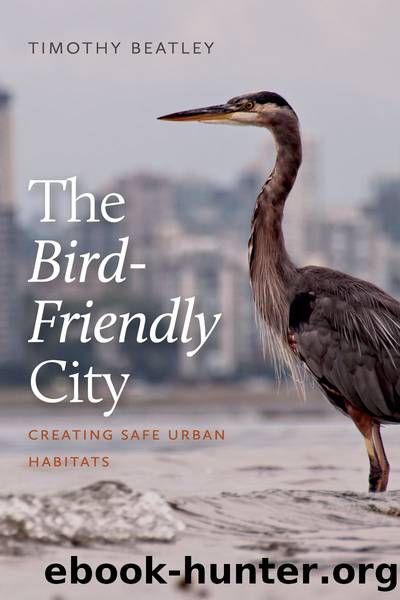The Bird-Friendly City by Timothy Beatley

Author:Timothy Beatley
Language: eng
Format: epub
Publisher: Island Press
Published: 2020-11-15T00:00:00+00:00
Figure 8â2 A key design element of the newly renovated Interface headquarters building in Atlanta, Georgia, is its unique facadeâat once a large image of an eastern US forest and a fritted exterior that makes the structure bird-safe. Photo credit: Tim Beatley
Figure 8â3 The distinctive Student Centre at Ryerson University in Toronto, Ontario, shows that building design can be bird-safe and also aesthetically interesting. Photo credit: FLAP Canada
The Dangers of Urban Light
We are losing the night sky everywhere in the world with the expansion of urban population centers and the artificial lighting that accompanies it. In 2018, J. K. Garrett, P. F. Donald, and K. J. Gaston released a study that showed the extent of the planetary reach of what is referred to as skyglow, or light pollution. This study specifically looked at the spatial overlap of skyglow with the planetâs key biodiversity areas (nearly fifteen thousand sites), including biodiversity hot spots rich in birdlife.28 The study found that fewer than one-third of these sites have âpristine night-time skies, ⦠and only about a fifth contain no area in which night-time skies are not polluted to the zenith.â In other words, two-thirds of these areas of high biodiversity were found to be subject to light pollution, and this number is increasing. Dark nighttime skies are in decline everywhere on the planet, with serious biological implications.
Nikki Belmonte of the Atlanta Audubon Society told me it is not just the lights of sprawling Atlanta but increasingly a larger lit-up landscape that crosses state boundaries: âIf you look at the light maps, weâre practically connected to Charlotte, up the 85 corridor.â Most birds migrate at night, and they wonât encounter only the lights of an occasional city or town but a much more expansive lightscape that includes highways like Interstate 85 and the associated sprawl and development that follows.
For animals such as birds and bats, such light pollution can be highly damaging. For birds, the intense lights of cities can be disorienting and can bring them into contact with glass facades. As Adam Betuel, conservation director for Atlanta Audubon, explained, birds are confused and attracted by the lights. The illuminated area âpulls them into the city,â he told me. âThey could be harmed at that point, but whatâs more likely to happen is that, as theyâve landed somewhere they [otherwise] wouldnât because of the attracted light, they then encounter reflective glass.â29 Birds disoriented by the lights of cities can become exhausted quickly, in turn becoming subject to predation or fatal window strikes. As Susan Elbin of New York City Audubon nicely put it, âThe light lures them in and the glass finishes them off.â30
Researchers with the Cornell Lab of Ornithology recently calculated the relative level of risk for 125 metropolitan areas in the continental United States by combining data on bird migration levels (using weather radar from 1995 to 2017) with the extent of radiance from artificial light at night. The authors developed a ranking of cities according to the level of exposure of migrating birds to nighttime light.
Download
This site does not store any files on its server. We only index and link to content provided by other sites. Please contact the content providers to delete copyright contents if any and email us, we'll remove relevant links or contents immediately.
The Lonely City by Olivia Laing(4568)
Animal Frequency by Melissa Alvarez(4150)
All Creatures Great and Small by James Herriot(3986)
Walking by Henry David Thoreau(3681)
Exit West by Mohsin Hamid(3634)
Origin Story: A Big History of Everything by David Christian(3472)
COSMOS by Carl Sagan(3347)
How to Read Water: Clues and Patterns from Puddles to the Sea (Natural Navigation) by Tristan Gooley(3240)
Hedgerow by John Wright(3106)
How to Do Nothing by Jenny Odell(3102)
The Inner Life of Animals by Peter Wohlleben(3099)
How to Read Nature by Tristan Gooley(3078)
Project Animal Farm: An Accidental Journey into the Secret World of Farming and the Truth About Our Food by Sonia Faruqi(3018)
Origin Story by David Christian(2991)
Water by Ian Miller(2951)
A Forest Journey by John Perlin(2915)
The Plant Messiah by Carlos Magdalena(2745)
A Wilder Time by William E. Glassley(2690)
Forests: A Very Short Introduction by Jaboury Ghazoul(2671)
